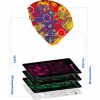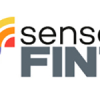Articles
Under the direction of Editor and Publisher Ian Michael, Spectroscopy Europe, and Spectroscopy World, have been writing about the latest trends in analytical sciences since 1975.
This article describes MALDI imaging’s potential uses in pathology applications, and the benefits of the technique to map hundreds of biomolecules (proteins, lipids and glycans, for example) in a label-free, untargeted manner or for imaging target proteins using a modified immunohistochemistry protocol, often from a single tissue section.
Despite a multitude of chemical and physical methods capable of detecting fingerprint residues, there are substantial challenges with fingerprint recovery. Spectroscopic methods have played a critical role in the analysis of fingerprints, used to identify the chemical constituents present, examine their degradation over time and compare the chemical variation between donors.
This article is about photoacoustic imaging and spectroscopy, and their use for looking inside us, where they have a number of benefits. Hilde Jans and Xavier Rottenberg explain the fundamentals and how new technology may be bringing a new photoacoustics age.
Eyes may or may not be the window into our souls, but it does seem that they are the window into our brains. This article explains how hyperspectral imaging (HSI) and optical coherence tomography (OCT) can be used to image the retina to diagnose Alzheimer’s Disease. The results are processed by machine learning and give the best performance when HSI and OCT data are combined.
What should we be calling the various types of spectral imaging? The authors lay out some suggestions and welcome your views.
The SensorFINT COST Action is a European Network for assuring food integrity using non-destructive spectral sensors.
Following our articles on the FAIR initiative, we now look at some examples of the FAIRification of data handling, collection and archiving.
How did a major trade show organiser cope with the disruption of COVID-19? Susanne Grödl, Exhibition Director of analytica for Messe München, gives her experience.
This article describes a recently introduced, rapid, laser-based hyperspectral method for thin-film analysis in the mid-IR fingerprint range.
With a significant proportion of our regular readership probably under home lock-down, we were wondering if we could help you at this difficult time by pointing out some useful online resources. So, when we finally come out of this pandemic, you could do so better skilled and more up-to-date than when we went in to it.
Tony and Lutgarde Buydens give us an update on the planning for the major EuroAnalysis 2021 conference, which is being held in Nijmegen, the Netherlands, at the end of August 2021. At this stage, they are keen to gather suggestions from readers on topics they would like to see covered. Groups are also invited to consider hosting their own event under the EuroAnalysis 2021 banner.
An interesting insight into, well, a week in the life of the author as a fourth-year PhD student. Katie is working on investigating a way of detecting liver damage using spectroscopy, which is “about as interdisciplinary as you can get”! I’m sure all readers will find it interesting and it may be helpful for those you know who may be considering a PhD.
The authors look at two important areas of recycling of waste materials: concrete and plastics. If aggregates are to be recycled from concrete, the presence of pollutants (plastics, foams, brick etc.) and the degree of removal of cement mortar from the aggregates must be assessed and monitored. NIR hyperspectral imaging with PLS does a good job of both tasks.
Coral reefs have been used as examples of climate change in action for decades, since the “bleaching” caused by corals stressed by heat expelling their symbiotic photosynthesising algae is such a dramatic effect. Jonathan Teague, Jack Willans, Michael Allen, Thomas Scott and John Day describe their work in developing a hyperspectral imaging system that can be deployed on a submersible remotely operated vehicle to monitor coral health through changes in their natural fluorescence
Tony Davies continues his quest to find out what you all need to work more efficiently. You will remember that in the last issue, Tony introduced his survey to discover what developments were needed in spectroscopy by readers. Some of the initial responses are explored, and Tony finds that he has opened a “can of worms”.
We all know how spectroscopy and other analytical technologies have played important roles in detecting fraud and in authentication. Paper collages, or photomontages, are part of the art market that is seeing much interest amongst collectors. It is difficult to detect forgeries just through expertise. The use of NIR imaging offers a number of ways to identify forgeries or authenticate the collage non-destructively; from determining the glue used to the revealing of printing on the back of the pieces or paper, which often have been taken from books and magazines.
It is not every issue that one of our articles starts with a quotation in medieval English, and it is appropriate as two of our articles cover the use of spectroscopy in cultural heritage. This is yet another field where the rich information provided by spectroscopy, along with its non-destructive nature (for many techniques), portability and ability to generate chemical images make it the answer to many questions. Kate Nicholson, Andrew Beeby and Richard Gameson are responsible for the medieval English at the start of their article “Shedding light on medieval manuscripts”. They describe the general use of Raman spectroscopy for the analysis of historical artefacts, and, in particular, their work on medieval European manuscripts and 18th century watercolour pigments. They stess the importance of checking the actual laser power density to avoid damage to priceless artefacts.
Terahertz spectroscopy and imaging of Paleolithic cave etchings, 14th century paintings in a church and a mid-20th century Italian painting are all described. This helps demonstrate the versatility of the technique as well as its potential in cultural heritage preservation.
Much of the exterior surface of plants is covered by the cuticle. This plays a vital role in protecting the plant from water loss, attack by pests and pathogens and damage from UV radiation. Infrared spectroscopy is very useful in characterising cuticles, as we learn in “Infrared spectroscopy as a tool to study plant cuticles” by José Heredia-Guerrero, José Benítez, Eva Domínguez, Ilker Bayer, Roberto Cingolani, Athanassia Athanassioua and Antonio Heredia. The authors point out that, whilst still in its early stages, infrared spectroscopy has provided valuable information about the functional groups, chemical structure and arrangement and interactions of plant cuticle components.





















